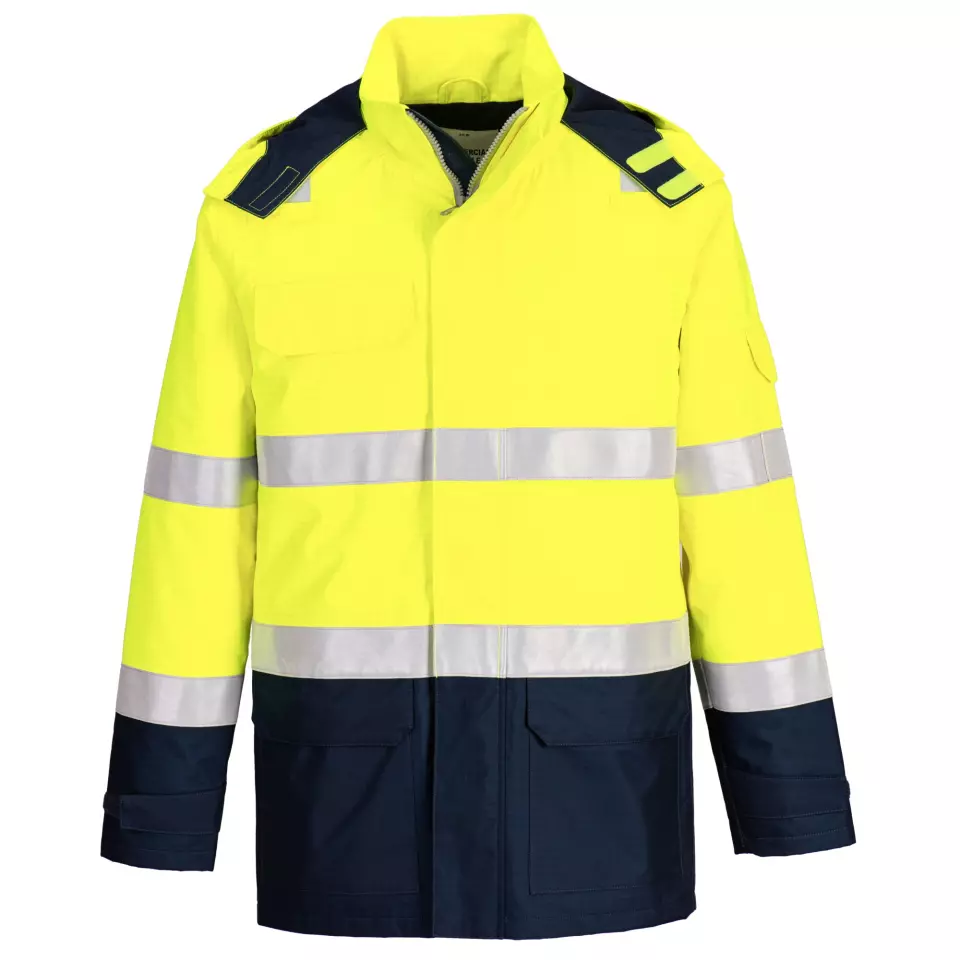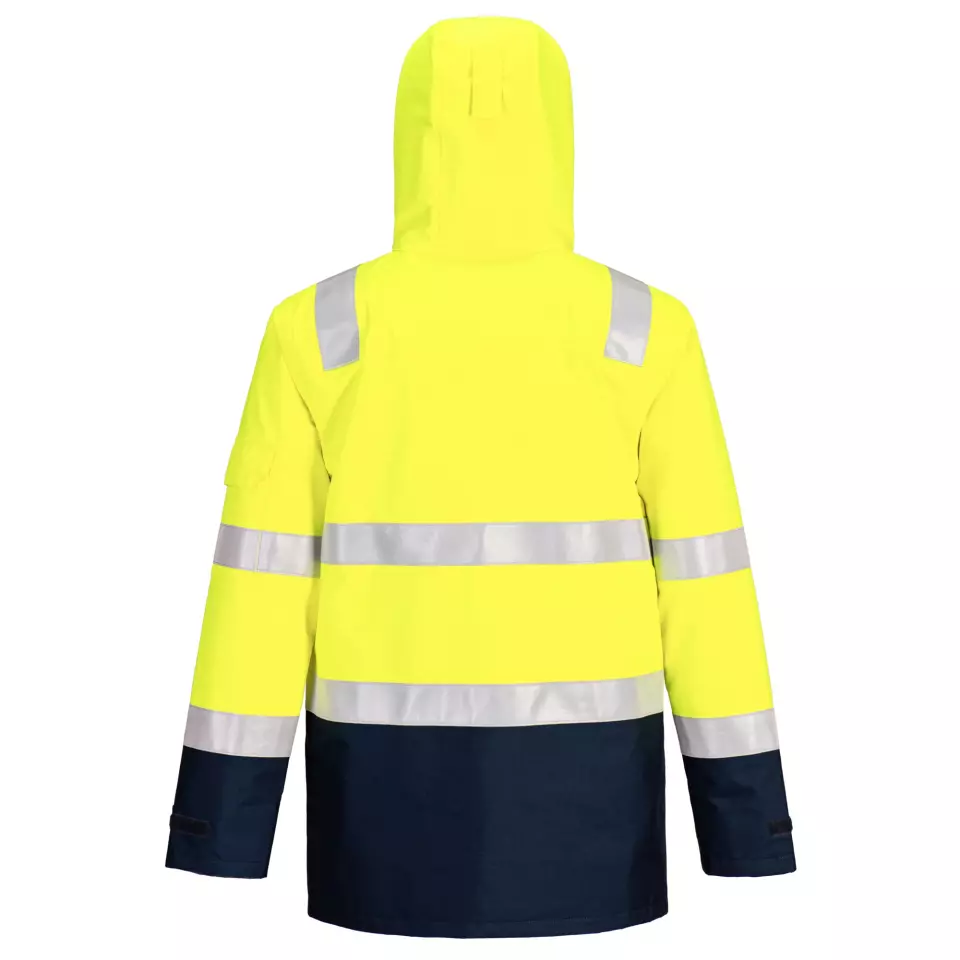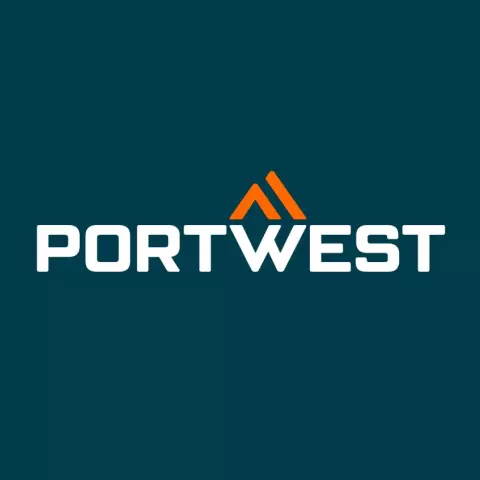Portwest Bizflame Rain+ Hi-Vis Light Arc FR Jacket, Yellow/Navy
Portwest
visit storeProduct description
This multi-norm flame resistant jacket provides comprehensive protection against fire, chemicals, rain, and arc flash hazards while maintaining high visibility standards. The waterproof fabric with FR cotton lining offers protection from radiant, convective and contact heat while ensuring comfort and warmth in adverse weather conditions. With an ergonomically shaped hood and multiple practical features, this jacket is designed for demanding industrial environments requiring versatile protection.
Product Features:
- Flame resistant treated waterproof fabric prevents water penetration
- FR cotton lined for added warmth and comfort
- Ergonomically shaped hood for perfect fit
- Internal chest pocket and concealed phone pocket
- Radio loops for easy clipping of a radio
Technical Details:
- Anti-static properties
- Sew on flame resistant industrial wash tape
- Taped seams for additional protection
- 40+ UPF rated fabric blocks 98% of UV rays
- Print access for corporate branding
Recommended Applications:
- Ideal in combination with FR410 trousers
- Suitable for environments requiring versatile protection
- Suitable to be worn in an ATEX environment
Standards:
- CE certified, CE-CAT III, UKCA marked
- EN ISO 11612 (A1+A2, B1, C1, F1)
- EN ISO 11611 Class 1 (A1+A2)
- EN 1149-5
- IEC 61482-2 IEC 61482-1-1 (ELIM 25 CAL/CM², ATPV 29 CAL/CM²)
- IEC 61482-2 IEC 61482-1-2 APC 2
- EN 13034 Type PB [6]
- EN ISO 20471 Class 3
- EN 343 (CLASS 4:1:X)
The method used to fasten the jacket or vest, affecting ease of use, security, and weather protection during work activities.
The design and structure of the neckline area, affecting protection from elements, professional appearance, and comfort around the neck and shoulders.
A chest pocket keeps your essential items and tools conveniently within easy reach.
Keep your phone safe, secure, and always within reach for ultimate convenience on the job.
An integrated hood provides essential head protection from the elements, keeping you dry and focused on the job.
Full-length sleeves provide essential protection and warmth, keeping your arms shielded from the elements and workplace hazards.
Determines how the jacket fits your body, affecting comfort, mobility, and layering options during work activities.
How the sleeve opening closes or fits at the wrist, affecting protection from elements and comfort during movement.
- Chemical Resistance
- Heat & Flame Resistance
- High Visibility
- Electrical Protection
- Water Resistance
- Welding
- UV Protective
- Machine Washable
Request a free sample
Test first and buy later. Visit any product page to request your free sample.
Standards and labels
EN IEC 61482-1-2:2018 is a European standard that specifies the safety requirements and test methods for clothing that is worn to protect the wearer from thermal hazards such as heat and fire. The standard lays out the minimum safety requirements for the design, construction and performance of the clothing, as well as the test methods for measuring its effectiveness in protecting the wearer from thermal hazards. Test results may include information on the clothing's thermal protection performance, flammability and other safety features. This standard is intended for use in industrial environments where the risk of thermal hazards is present, such as in welding, metal cutting and other operations that generate heat or fire. This standard applies to flame-resistant clothing for thermal hazard protection, and it includes the test methods to determine the thermal protection performance of materials and clothing.
Test results
Low-voltage Circuit Arc APC 2The standard EN IEC 61482-1-2:2018 addresses the testing requirements for protective clothing against the thermal hazards of an electric arc. The test result APC 2 signifies that the product falls under Arc Protection Class 2. This indicates a middle level of protection, as specified by the standard, where the product successfully withstands a definite level of energy exposure, providing a defined level of safety to the wearer. The test for this standard involves simulating an electric arc scenario to measure the clothing's capacity to resist the thermal effects. The test method, Box Test, incorporates specific configurations of electrodes and electrical settings to mimic the heat and pressure of an electric arc. The material or garment is subjected to this controlled environment to assess its protective characteristics. Understanding this classification is fundamentally important when procuring protective gear for environments with electrical hazards, as it directly relates to the safety and adequacy of the protective clothing in preventing burns from an electric arc.
EN IEC 61482-1-1:2019 is a European standard that specifies the requirements and test methods for flame-resistant clothing for electric arc protection. It lays out minimum performance requirements for the design, construction, and performance of flame-resistant clothing, as well as test methods to measure its effectiveness in protecting the wearer from an electric arc. Test results may include information on the clothing's arc protection performance, thermal protection, and flammability. This standard is for flame-resistant clothing that is intended for use in electrical environments where the risk of an electric arc is present. It covers the general requirements for flame-resistant clothing for electric arc protection and test methods for the determination of the arc protection performance of materials and clothing.
EN 13034:2005 is a European standard that specifies the requirements and test methods for Type 6 protective clothing designed to provide protection against liquid chemicals. This standard sets criteria for the fabric's resistance to penetration by liquid chemicals and establishes guidelines for the overall design and construction of the clothing. It ensures that Type 6 protective clothing offers reliable protection for workers in industries where they may be exposed to liquid chemical hazards, but it may not be suitable for protection against airborne particles.
Test results
Liquid Chemical Protection Type 6 PBEN 13034:2005 specifies the performance requirements for protective clothing that offers limited protection against liquid chemicals, identified specifically as Type 6 PB (partial body protection). The 'Type 6 PB' designation implies that the protective garment has been tested and confirmed to provide effective defense against light spray and minor splashes of liquid chemicals, but only for parts of the body such as aprons, sleeves, or boots rather than full body suits. This standard tests the fabric's barrier effectiveness by applying a defined volume of liquid to the garment and assessing any penetration or repellence under controlled laboratory conditions. Garments achieving Type 6 PB classification are crucial for tasks in industries like chemical processing or handling where full body coverage is unnecessary, thereby offering flexibility and targeted protection, reducing the risk of chemical exposure to critical areas of the body.
EN 1149-5:2008 is a European standard that specifies the requirements for electrostatic dissipative (ESD) gloves. The standard defines performance requirements for material, design, and testing of ESD gloves. The gloves must be able to effectively discharge static electricity and protect the wearer from ESD. Testing includes measuring the surface resistance of the glove material. Pass/fail results are based on the gloves meeting or not meeting the specified requirements.
Test results
Material Performance TestedThe EN 1149-5:2008 standard specifies the performance requirements for material used in protective clothing designed to avoid incendiary discharges. The test result Tested means that the material has undergone relevant evaluation procedures to confirm its static dissipative properties. These tests generally involve measuring the electrical resistance of the material in ohms (Ω) to determine its capability to dissipate electrostatic charges and prevent sparking that could ignite flammable substances. The practical implications of this result for the respective product category (like protective workwear for use in explosive atmospheres) are significant, as it ensures that the clothing provides a level of protection against electrostatic discharges, potentially reducing the risk of fire or explosion in environments with flammable gases, vapors, or dusts.
EN 11612:2015 is a European standard that specifies the requirements for protective clothing against heat and flame. This standard defines performance requirements for material, design, and testing of clothing that protects the wearer from heat and flames. Testing includes measuring the clothing's resistance to heat and flame, as well as its ability to self-extinguish. Pass/fail results are based on the clothing meeting or not meeting the specified requirements.
EN 343 is a European standard for protective clothing against bad weather. It says clothes must be waterproof, breathable, and not let water in. It's used to protect workers in different industries like construction and transportation. Tests must show the clothing meets these standards.
Test results
Breathability Class 1In the standard EN 343:2019, Breathability Class 1 specifies the lowest (RET > 40) level of breathability for protective clothing against rain. This class is designated for garments that have a tested breathability value which meets the minimum requirement for water vapor resistance according to the specifications laid out in the standard. The practical implication of a Class 1 result is that the garment allows a limited amount of water vapor to pass through, making it suitable for less intensive or shorter duration activities in wet conditions.
Waterproofness Class 4EN 343:2019 is a standard that sets forth requirements and test methods for protective clothing, specifically focusing on garments intended to offer protection against precipitation and wet conditions, ensuring waterproofness and breathability. Class 4 signifies the highest level of waterproof performance, indicating that the garment effectively prevents water penetration under high hydrostatic pressure. This classification suggests that the garment offers superior protection against heavy rain and wet conditions, keeping the wearer dry and comfortable. The test method involves subjecting fabric samples to a specified water pressure for a predetermined duration and assessing any water penetration. Garments achieving Class 4 in Waterproofness are highly suitable for use in environments where protection against heavy rain and prolonged exposure to moisture is essential, such as outdoor work and activities in inclement weather conditions, ensuring user safety and comfort.
Downpour XEN 343:2019 is a standard that delineates requirements and assessment methodologies for protective clothing, specifically tailored to garments intended to offer protection against precipitation and wet conditions.Result X signifies that the garment's performance in resisting water penetration during simulated downpours has not been specified or assessed. The practical implications of this result are notable, as it indicates that the garment may not offer adequate protection against heavy rain and prolonged exposure to wet conditions, potentially compromising wearer comfort and safety, particularly in outdoor work environments where protection from inclement weather is paramount.
EN 11611:2015 is a European standard that specifies the requirements for protective clothing for use in welding and allied processes. This standard defines performance requirements for material, design, and testing of clothing that protects the wearer from heat and flames. Testing includes measuring the clothing's resistance to heat and flame, as well as its ability to self-extinguish. Pass/fail results are based on the clothing meeting or not meeting the specified requirements.
Test results
Welding Protection Class 1The standard EN 11611:2015 establishes criteria for protective clothing used during welding and allied processes, specifically regarding safety to reduce the risk of harm from sparks, spatter, and other hazards associated with welding. In this context, a Class 1 test result indicates the clothing provides basic protection suitable for less hazardous welding techniques where lower levels of spatter and radiant heat are anticipated. The test for this classification involves subjecting the fabric to controlled ignition and monitoring its resistance to flame spread, heat transfer, and the formation of holes. The fabric material must neither ignite nor continue to burn after the source of ignition is removed. In practical terms, products achieving Class 1 under EN 11611:2015 are suitable for types of welding that produce lower spatter and radiant heat, making them ideal for less intense welding operations but not for those that involve higher risks that might require more robust protective gear categorized in higher classes.
EN 61482-2:2020 is a European standard that sets safety requirements for protective clothing against electric arc thermal hazards. This standard specifically deals with the protection of the body and limbs (excluding hands and feet) against electric arc thermal hazards from an electric arc. It defines the performance levels for protective clothing, including the level of protection against electric arc thermal hazards, the arc thermal performance and the classification of clothing. The standard also includes test methods to measure the performance of the clothing, such as measuring the incident energy on the clothing and the flame spread. The test results should show that the clothing meets the minimum requirements for protecting the wearer from electric arc thermal hazards.
Test results
Reflective Strip Area Grade 3The EN ISO 20471:2013 standard specifies the requirements for high-visibility clothing, with a specific focus on the reflective strip area, a crucial element for ensuring visibility in low-light conditions. A test result achieving Grade 3 indicates the highest level of reflectivity performance in this standard, ensuring optimal visibility and safety for the wearer in various lighting conditions. In grade 3 products reflective tape is 0.20 m2 and fluorescent material is 0.8 m2.The test methodology involves assessing the amount and quality of retroreflective material on garments. This is quantified under precise conditions to ensure that the reflective strips meet stringent visibility requirements even from significant distances or in poor lighting conditions. Garments that meet Grade 3 requirements are suitable for use in high-risk environments where being seen by others is crucial for safety, such as road construction sites, airport ground operations, and other scenarios with high vehicular traffic or complex visual backgrounds.
CE Marking is a label that shows a product meets certain safety and environmental standards set by the European Union. To get the CE Marking, a company must test and certify their product meets these standards. CE Marking is required for many products sold in the EU, including electronics, machinery, toys and medical devices. It helps ensure that products are safe for consumers and the environment, and allows for easy trade within the EU.
PPE stands for "personal protective equipment." PPE Category 3 refers to equipment that is complex and provide the highest level of protection such as powered respirators, SCBA, and full body suits. In Europe, PPE Category 3 must meet certain safety standards set by the European Union, which means that it must be designed and manufactured to protect the user without causing harm. Companies that make or sell PPE must prove that it meets these standards. They also must have a quality management system in place, have to be audited regularly by a notified body and have to have a technical documentation.
Portwest delivery terms
Free delivery when you order more than 300,00 € from Portwest
Supplier shipping fee 4,92 €
Brand minimum 20,00 €
165,19 €
Shipping fee is 4,92 € for orders under 300,00 €
Sold in units of one piece
Need larger quantities?
Other products you may like
Recently viewed
Need help?
Get help from our experts
Other products you may like
Similar products you may like
Autonomous sourcing platform
The most efficient way to source and order supplies for your operations
Sourcing
Ordering
List products you’re looking for and we’ll find the best products and prices for you – all for free.
Need help?
Get help from our experts




